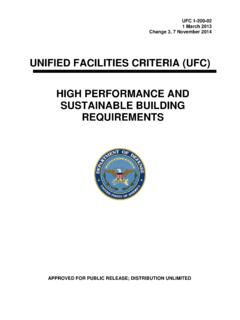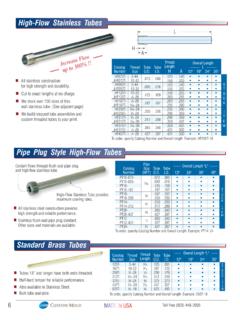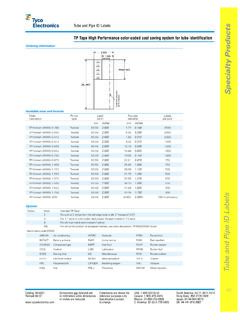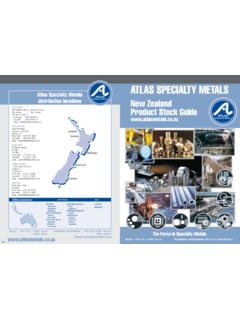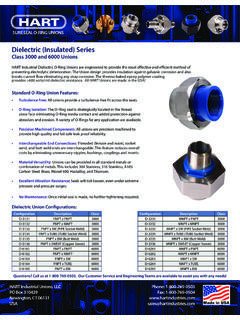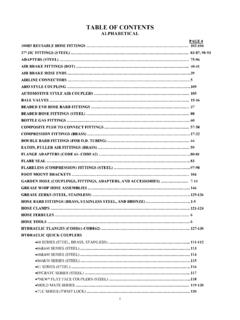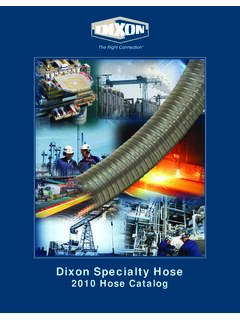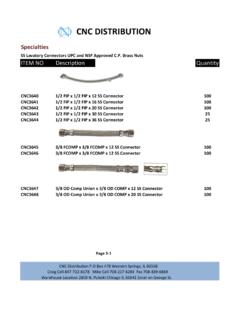Transcription of Updated Frequently Asked Questions Specialty Metals 05-04 …
1 1 Frequently Asked Questions Regarding the Specialty Metals Restriction under 10 2533b As of July 29, 2009 CAUTION: THESE FA QS ARE FOR GENERAL INFO RMATION AND ARE NOT DEFINITIVE. THE STATUTE AND REGULATIONS SHOULD ALWAYS BE REVIEWED FOR THE DEFINITIVE RULES THAT APPLY TO INDIVIDUAL FACT SITUATIONS. ADDITIONALLY, THESE FAQS DO NOT TAKE INTO ACCOUNT ANY RESTRICTIONS REQUIRED TO COMPLY WITH EXPORT CONTROL LAWS SUCH AS THE ITAR OR EARS. General Questions : Q1. What is the history of this domestic preference restriction? A1. The Specialty Metals restriction was originally added to the Berry Amendment in 1972, and was included annually in DoD Authorization Acts. It was codified in 10 2533a in 2002 by section 832 of Public Law 107-107. On October 17, 2006, the President signed the National Defense Authorization Act for Fiscal Year 2007. Under this Act, Section 842 moved the Specialty Metals r estriction from 10 2533a to 10 2533b, with revisions.
2 The Department of Defense issued Class Deviation 2006-O0004 dated December 6, 2006. On October 26, 2007, the Department issued Class Deviation 2007-O0011 stating that 10 2533b(a)(1) as a statut e was inapplicable to the acquisition of commercial off-the- shelf items, in accordance with 41 431. On January 28, 2008, the President signed the National Defense Authorization Act for Fiscal Year 2008. Under this Act, sections 804 and 884 addressed further changes to 10 2533b. Section 804 included a statutory exception for COTS items, with certain limitations for fasteners, as well as castings and forgings. Section 804 expanded the electronic components exception, and provided new exceptions, such as a de mini mis exception (does not apply to high performance magnets), a commercial derivative military articles exception, and a national security waiver. Section 804 removed the implication that accepting non-compliant material may create an Anti-deficiency Act violation, while placing the burden of compliance on the prime and subcontractors.
3 This Act also tight ened some aspects of the law. For example, the definition of required form contained in the availabi lity exception was changed to refer to the Specialty Metals itself, and not to parts containing Specialty Metals . Section 884 contained stricter rules on how to process Domestic Nonavailability Determinations under the availability exception. The Department issued Class Deviation 2008-O0002 on January 29, 2008 incorporating most of the changes in this Act. 2 These laws have been implemented in the Defense Federal Acquisition Regulation Supplement (DFARS) on July 29, 2009 and are to be incorporated into new procurement actions after this date. Q2. Where can I find information regarding DoD s implementation of the new Specialty Metals restriction? A2. The Director, Defense Procurement (DPAP), maintains a web site of the most current reference material relating to Specialty Metals at: The definition of Specialty Metals is provided at DFARS 7009(a)(11).
4 Q3. Are there any exceptions to this restriction on Specialty Metals ? A3. Yes, there are a number of exceptions provided for in the law. When a contractor or subcontractor proposes to rely on a particular exception, that fact should be included in the proposal, and the contracting officer has the responsibility to determine if the exception applies. The resulting prime and subcontracts will need to specifically state what exceptions were accepted by the Department prior to award. The exceptions are summarized below. 1. The Specialty Metals restriction does not apply if the Government prime contract is below the Simplified Acquisition Threshold (SAT). The value of subcontracts is not relevant: only the prime contract value determines this exception. If the prime contract is over the SAT, the prime contractor and every subcontractor must comply with the Specialty Metals restriction on prime contracts for: (1) the following types of end items, or components thereof: aircraft, missiles and space systems, ships, tank-automotive, weapon systems, and ammunition, and (2) the purchase of Specialty metal ( raw stock, including bar, billet, slab, wire, plate, and sheet) acquired by the prime contractor for delivery to DoD as an end item, or Specialty metal acquired by DoD directly from the entity that melted or produced the Specialty metal .
5 2. Availability exception. A domestic non-availability determination (DNAD)) to the Specialty metal restriction may be granted if the Under Secretary of Defense for Acquisition, Technology and Logistics (USD(AT&L) or the Secretary of the Military Department concerned determines that compliant Specialty metal of satisfactory quality, 3 sufficient quantity, and in the requi red form, cannot be procured as and when needed. See the definition of in the required form at DFARS 252,225-7009(a)(10). o Documentation required for a DNAD: An analysis of alternatives that would not require a domestic non- availability determination (a detailed market analysis and corrective action plan); and Written documentation by the requiring activity, with specificity, why such alternatives are unacceptable. Specify the duration and scope of the DNAD o If the DNAD will apply to more than one contract ( , a class DNAD), approval of the USD(AT&L) is required.
6 O At least 30 days before making such a determination, in a manner consistent with national security and confidential business information, the contracting agency must publish a notice on the Federal Business Opportuntities website ( or any successor site) of the intent to make the domestic nonavailability determination; and solicit information in accordance with DFARS (b)(5)(ii)(A) and (B). o Who can make Domestic Non-Availability Determinations for Specialty Metals ? The Under Secretary of Defense (Acquisition, Technology, and Logistics). The Secretary of the Army. The Secretary of the Navy. The Secretary of the Air Force. This authority cannot be redelegated. 3. The Specialty Metals restriction does not apply to acquisitions outside the United States in support of combat operations. 4. The Specialty Metals restriction does not apply to acquisitions o In support of contingency operations (see definition of contingency operations in 10 100); or o For which the use of other than competitive procedures has been approved on the basis of unusual and compelling urgency in accordance with FAR 4 5.
7 The Specialty Metals restriction does not apply to acquisitions of items specifically for resale by commissaries, exchanges, and other nonappropriated fund instrumentalities. 6. The Specialty Metals restriction does not apply to items containing Specialty Metals or Specialty Metals themselves when the acquisition furthers an agreement with a qualifying country (see DFARS (9)) ( , the Specialty metal was melted or produced in a qualifying country or is contained in an item manufactured in a qualifying country. 7. The Specialty Metals restriction does not apply to procurements of electronic components. See the definition of electronic components in DFARS (a)(5). 8. The Secretary of Defense or the Secretary of the military department may accept non- compliant Specialty Metals if the Specialty Metals were incorporated into items produced, manufactured, or assembled in the United States before October 17, 2006, and the contracting officer for the contract determines that the cont ractor is not in compliance with 10 USC 2533b, and also determines in writing that - o It would not be practical or economical to remove or repl ace the Specialty Metals incorporated in such items or to substitute items containing compliant materials; o The prime contractor and subcontractor responsible for providing items containi ng non-compliant materials have in place an effective plan to ensure compliance with 10 2533b for items produced, manufactured, or assembled in the United States after October 17, 2006.)
8 And o The non-compliance is not knowing or willful, as represented by the contractor and subcontractor; and o The Under Secretary of Defense for Acquisition, Technology, and Logistics or the service acquisition executive (SAE) of the military department concerned approves the determination. o A notice must be posted in by the contracting officer within 15 days after making a determination that a waiver has been 5 granted and that a contracting officer may exercise this authority only with respect to the delivery of items where final acceptance takes place after October 17, 2006 and before September 30, 2010. Q4. How would I know if incorporation of non-compliant Specialty Metals by the contractor or subcontractor was not knowing or willful ? A4. The contracting officer should ascertain that this topic was not specifically addressed in the proposal or negotiations and request a statement from the prime contractor and the subcontractor responsible for the noncompliance stating it was inadvertent.
9 Failure to flow down requirements does not meet the criteria for not knowing. Making a business decision without requesting relief from the statute does not meet the criteria for not willful. Q5. How does the Specialty Metals restriction differ from the Buy-American Act? A5. The Buy American Act (BAA) (41 10a through 10d) and the Specialty Metals restriction ( 10 2533b) are two separate laws implemented by two different regulations. They differ with regard to their scope, threshold, exceptions, and waiver authority. The Specialty Metals restriction is applicable to all purchases noted in Answer 1, over the simplified acquisition and applies even if another agency, such as the GSA, is purchasing the item on behalf of the DoD. Unless an exception applies, it requires that all 100% of the Specialty Metals in end items or components of airplanes, missile and space systems, ships, tank and automotive items, weapon systems, or ammunition be melted or produced in the or a qualifying country.
10 It requires that any Specialty metal (raw bar stock, wire rod, sheet, plate, etc.) bought by DoD or a prime contractor for delivery to DoD as an end item be melted or produced only in the With few exceptions, the BAA applies to all supplies or construction materials over the micro-purchase threshold for use in the The BAA requires application of a differential f actor to the evaluated cost or price of supplies that are not domestic end products. A two part test is used to define a domestic end product: (1) the end product must be manufactured in the and (2) the cost of all its domestically manufactured components must exceed 50% of the cost of all its components. 6 The BAA is applicable to the entire Federal Government. The BAA does not preclude foreign firms from competing for Federal contracts for supplies or construction materials. However the Act does require that an evaluation factor be placed on proposals offering end items other than domestic end items.


